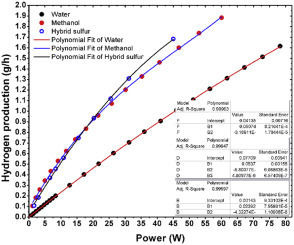International Journal of Hydrogen Energy ( IF 8.1 ) Pub Date : 2018-01-04 , DOI: 10.1016/j.ijhydene.2017.12.084 H. Tebibel , R. Medjebour

|
This paper presents comparative performance analysis of photovoltaic (PV) hydrogen production using water, methanol and hybrid sulfur (SO2) electrolysis processes. Proton exchange membrane (PEM) electrolysers are powered by grid connected PV system. In this system design, electrical grid is considered as a virtual energy storage system (VESS) where the surplus of PV production can be injected and subsequently taken to support the electrolyser. Methanol (ME) and hybrid sulfur (HSE) electrolysis are compared to the conventional water electrolysis (WE) in term of operating cell voltage. Based on the experimental results reported in the literature, semi-empirical models describing the relationship between the hydrogen production rate and the electrolyser cell power input are proposed. Furthermore, power and hydrogen management strategy (PHMS) is developed. Case study is carried out to show the impact of each type of electrolysis on the system component sizes and evaluate the hydrogen production potentialities. Results show that the use of ME allows to produce 65% more hydrogen than with using WE. Moreover, the amount of hydrogen produced is almost double in the case of HSE. At Algiers city, based on a grid connected PV/Electrolyser system, it is possible to produce about 25 g/m2 d and 29 g/m2 d of hydrogen, respectively, through ME and HSE compared to 15 g/m2 d of hydrogen when using WE.
中文翻译:

使用PEM水,甲醇和混合硫磺电解制氢的并网光伏系统的比较性能分析
本文介绍了使用水,甲醇和杂化硫(SO 2)电解过程。质子交换膜(PEM)电解槽由并网的光伏系统供电。在此系统设计中,电网被视为虚拟能源存储系统(VESS),可以在其中注入多余的PV产品,然后将其用于支撑电解槽。就工作电池电压而言,将甲醇(ME)和杂化硫(HSE)电解与常规水电解(WE)进行了比较。基于文献报道的实验结果,提出了描述氢气产生速率与电解槽功率输入之间关系的半经验模型。此外,还开发了功率和氢管理策略(PHMS)。进行了案例研究,以显示每种类型的电解对系统组件尺寸的影响并评估制氢潜力。结果表明,与使用WE相比,使用ME可以产生多65%的氢气。此外,在HSE的情况下,产生的氢气量几乎增加了一倍。在阿尔及尔市,基于并网的光伏/电解系统,产量约为25 g / m通过ME和HSE分别产生2 d和29 g / m 2 d的氢,而使用WE时则为15 g / m 2 d的氢。











































 京公网安备 11010802027423号
京公网安备 11010802027423号